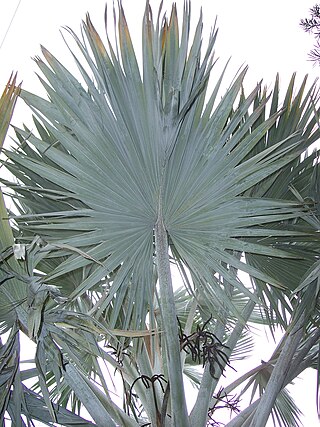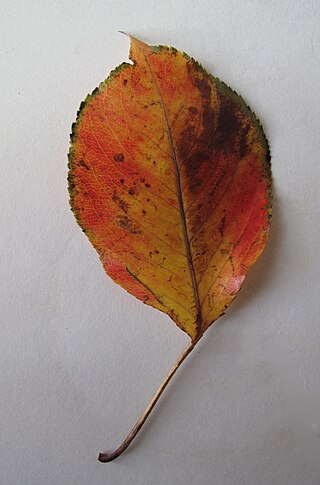
The Rutaceae is a family, commonly known as the rue or citrus family, of flowering plants, usually placed in the order Sapindales.

Cycads are seed plants that typically have a stout and woody (ligneous) trunk with a crown of large, hard, stiff, evergreen and (usually) pinnate leaves. The species are dioecious, that is, individual plants of a species are either male or female. Cycads vary in size from having trunks only a few centimeters to several meters tall. They typically grow very slowly and live very long. Because of their superficial resemblance, they are sometimes mistaken for palms or ferns, but they are not closely related to either group.

Gunnera is the sole genus of herbaceous flowering plants in the family Gunneraceae, which contains 63 species. Some species in this genus, namely those in the subgenus Panke, have extremely large leaves. Species in the genus are variously native to Latin America, Australia, New Zealand, Papuasia, Hawaii, insular Southeast Asia, Africa, and Madagascar. The stalks of some species are edible.

The Strelitziaceae comprise a family of monocotyledonous flowering plants, very similar in appearance and growth habit to members of the related families Heliconiaceae and Musaceae. The three genera with seven species of Strelitziaceae have been included in Musaceae in some classifications, but are generally recognized as a separate family in more recent treatments such as the APG II system (2003). The APG II system assigns the Strelitziaceae to the order Zingiberales in the commelinid clade.

Cattleya is a genus of orchids from Costa Rica south to Argentina. The genus is abbreviated C in trade journals.

Nicotiana glauca is a species of flowering plant in the tobacco genus Nicotiana of the nightshade family Solanaceae. It is known by the common name tree tobacco. Its leaves are attached to the stalk by petioles, and its leaves and stems are neither pubescent nor sticky like Nicotiana tabacum. It resembles Cestrum parqui but differs in the form of leaves and fusion of the outer floral parts. It grows to heights of more than two meters.

Hevea is a genus of flowering plants in the spurge family, Euphorbiaceae, with about ten members. It is also one of many names used commercially for the wood of the most economically important rubber tree, H. brasiliensis. The genus is native to tropical South America but is widely cultivated in other tropical countries and naturalized in several of them. It was first described in 1775.

Ravenala is a genus of monocotyledonous flowering plants. Classically, the genus was considered to include a single species, Ravenala madagascariensis, commonly known as the traveller's tree, traveller's palm or East-West palm, from Madagascar. It is not a true palm but a member of the family Strelitziaceae. The genus is closely related to the southern African genus Strelitzia and the South American genus Phenakospermum. Some older classifications include these genera in the banana family (Musaceae). Although it is usually considered to be a single species, four different forms have been distinguished. Five other species were described in 2021, all from Madagascar: Ravenala agatheae Haev. & Razanats., R. blancii Haev., V.Jeannoda & A.Hladik, R. grandis Haev., Razanats, A.Hladik & P.Blanc, R. hladikorum Haev., Razanats., V. Jeannoda & P.Blanc, R. madagascariensis Sonn., et R. menahirana Haev. & Razanats.

The Nukak[nɨkãk] people live between the Guaviare and Inírida rivers, in the depths of the tropical humid forest, on the fringe of the Amazon basin, in Guaviare Department, Republic of Colombia. They are nomadic hunter-gatherers with seasonal nomadic patterns and practice small-scale shifting horticulture. They were classified as "uncontacted people" until 1981, and have since lost half of their population primarily to disease. Part of their territory has been used by coca growers, ranchers, and other settlers, as well as being occupied by guerrillas, army and paramilitaries. Responses to this crisis include protests, requests for assimilation, and the suicide of leader Maw-be'. An estimated 210–250 Nukak people live in provisional settlements at San José del Guaviare, while about as many live nomadically in the Nukak Reservation (Resguardo).

Fan palm as a descriptive term can refer to any of several different kinds of palms (Arecaceae) in various genera with leaves that are palmately lobed. Most are members of the subfamily Coryphoideae, though a few genera in subfamily Calamoideae also have palmate leaves. Fan palm genera include:

Butia is a genus of palms in the family Arecaceae, native to the South American countries of Brazil, Paraguay, Uruguay and Argentina. Many species produce edible fruits, which are sometimes used to make alcoholic beverages and other foods. The name is derived from a Brazilian vernacular word for members of the genus.
Güeppi-Sekime National Park is a protected area located in the Peruvian region of Loreto, on the border with Ecuador. The park encompasses 203,628.51 hectares (2,036 km2) of forests in a landscape that features hills and seasonally flooded lowlands.

In botany, the petiole is the stalk that attaches the leaf blade to the stem, and is able to twist the leaf to face the sun. This gives a characteristic foliage arrangement to the plant. Outgrowths appearing on each side of the petiole in some species are called stipules. The terms petiolate and apetiolate are applied respectively to leaves with and without petioles.

Attalea is a large genus of palms native to Mexico, the Caribbean, Central and South America. This pinnately leaved, non-spiny genus includes both small palms lacking an aboveground stem and large trees. The genus has a complicated taxonomic history, and has often been split into four or five genera based on differences in the male flowers. Since the genera can only be distinguished on the basis of their male flowers, the existence of intermediate flower types and the existence of hybrids between different genera has been used as an argument for keeping them all in the same genus. This has been supported by recent molecular phylogenies.

Chelyocarpus is a genus of small to medium-sized fan palms which are native to northwestern South America. Some are upright trees, while others creep along the ground. Species are used for thatch, to weave hats, stuff pillows and as a source of salt.

Itaya amicorum is a medium-size fan palm that is native to Brazil, Colombia and Peru. It is the only species in the genus Itaya. It was unknown to science until 1972, when it was discovered on the bank of the Itaya River in the Peruvian Amazon.

Marcgravia is a genus of plants in the Marcgraviaceae family commonly eaten by the dwarf little fruit bat. The genus is native to the Caribbean Islands, Central America, and South America, and genus is named in memory of the German naturalist Georg Marcgraf. The plant is visited by Thomas's nectar bat.
Barcella is a monotypic genus of flowering plant in the palm family found in the States of Amazonas and Roraima in northwestern Brazil. The only known species is Barcella odora which is used by the Brazilian peoples in construction and for various thatched goods.
Lepidocaryum is a monotypic genus of flowering plant in the palm family from South America where the lone species, Lepidocaryum tenue, is commonly called poktamui. Nine species names have been published, but palm taxonomists currently agree that just one variable species includes them all. The most reduced member of the Lepidocaryeae, it is similar in appearance to three closely related genera, Mauritia, Mauritiella, and Lytocaryum. The genus name combines the Greek words for "scale" and "nut" and the species epithet is Latin for "thin".

Mauritiella is a dioecious genus of flowering plant in the palm family found in South America where it is commonly called buriti. It is named after the similar and closely related genus Mauritia.

















